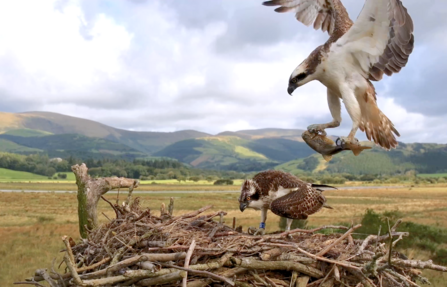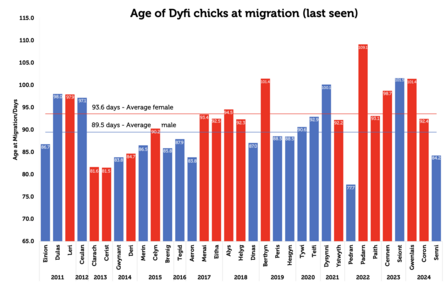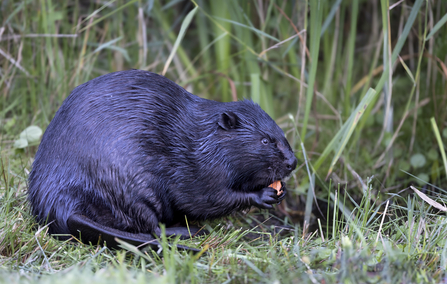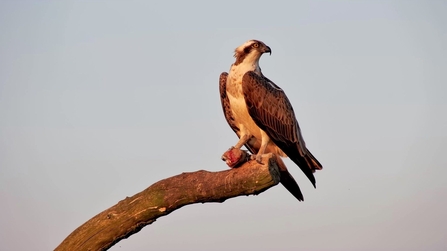Idris was the last to go. He waited patiently for his last offspring to go, stayed around a couple more days to make absolutely sure, before finally heading off for his winter break.
Idris was at the Dyfi for five months and two days.
Migration
Idris was the last to go. He waited patiently for his last offspring to go, stayed around a couple more days to make absolutely sure, before finally heading off for his winter break.
Idris was at the Dyfi for five months and two days.

The last supper. Gwenlais is gifted her last free fish she’ll receive for few years.
Here are the last-seen dates for all our 2024 ospreys:
🦅 TELYN: 22nd August at 18:42
🦅 IDRIS: 1st September at 08:54
🦅 CORON: 22nd August at 18:00 (92.4 days old)
🦅 GWENLAIS: 30th August at 11:16 (101.4 days old)
🦅 SENNI: 16th August at 10:26 (84.2 days old)
Ospreys migrate on their own, not in any kind of family group. Gwenlais, Coron and Senni may never see each other again, nor their parents. If they do, it’s down to pure “it's a small world” coincidence.
Here is the key-date summary for 2024:

2024 Key Dates
So how do our three youngsters fit into the overall pattern of all Dyfi offspring going back 14 years to 2011?
Well, Coron migrated at 92.4 days old, right around the average age for females. Senni, however, went a little earlier than normal, while his sister stayed around and made it into the Century Club.
Here is how they compare to previous years:

Migration ages 2011-2024
Science Corner
If we apply some behavioural ecology to these numbers, here’s what I came up with:
Key takeaways:
The above chart is interesting. As opposed to earlier season metrics that are governed more by biology (egg laying, hatching), the decision to migrate is much more of an individual choice.
So long as the bird is developed enough to fly, individual decisions play a more prominent role in migration age than any other metric.
This is borne out, for example, by simply glancing at this chart.
There is huge variability in migration ages, ranging from just 77 .7 days (Pedran 2022) and his sister at 109.1 days (Padarn 2022) the same year. That's an extra 31.4 days to make the same decision - over a month difference.
Or put another way, Padarn 'chose' to take an extra 40% more time than Pedran to go, and 20% more time than the average Dyfi female to migrate.
Given enough data and years, it would be interesting to compare these different migration ages against the birds that return and breed as adults. Does staying longer at the natal nest give young ospreys an advantage, or is the opposite true?
Or is it that age at migration has no overall effect on future return success?
Who are you..?
We also had record-equalling number of ‘intruder’ ospreys to our nest in 2024. Eleven in total, but there will be a load more that didn’t come close enough to the nest to ID, or were simply un-ringed (most ospreys in Scotland are not ringed).
No doubt we’ll hear more about some of these birds in future years… coming to a nest near you.
Here is the chart for this year:

Intruders identified in 2024
Ringing Video
A few people tell us that they missed the ringing video this year. I think Youtube’s algorithm has changed recently to promote more videos that are monetised. Despite losing revenue, we don’t do this so that you’re not constantly bombarded by pop-ups and annoying, repetitive ads.
If you missed it, or just want to see it again, voilà:
Ringing Video 2024: Monster Chicks (https://www.youtube.com/watch?v=LiwlqfhMBuk)
Ringing Video 2024: Monster Chicks
And finally…
Dyfi Osprey Project closes today, Sunday 8th September.
After being open for almost 200 days straight, the Dyfi Wildlife centre will be closed tomorrow, only to re-open on Wednesday (11th September) as we transition into winter mode: Open every Wednesday to Sunday until Christmas (10am – 4pm), including Caffi Tŷ Maenan of course.
The Live Streaming will go off tonight at 8pm.
All being well, we’ll set up another Christmas Live Streaming in December, so that you can see what the nest, Cors Dyfi Reserve and the Dyfi Estuary look like in the midst of winter. Oh, there will be beavers too.

Barti - a black morph beaver
As we prepare for our volunteer party tonight, I’d just like to express our overwhelming gratitude to all of them. Not going to mention individual names, but they all do an amazing job. Most of the people you see in red shirts at DOP are, in fact, volunteers.
We don’t give them badges to say they’re volunteers. We don’t give them volunteer uniforms – they wear the exact same red shirts as staff do. We make no distinction. They are just as important, if not more so, that paid staff. The only thing they are not permitted to do, is to ever say “I’m only a volunteer here”.
Telyn and Idris have had another successful year. This was their second hat-trick year in five years; their productivity rate is phenomenal when measured as successful offspring that made it to migration age.
Telyn and Idris’ total number is 12 migration-aged offspring (in five years), that’s an average of 2.4 offspring per season. That’s over 100% more than the UK average.
Thank you to all of you for supporting us throughout 2024. If you would like to donate to our cameras appeal, here's a link. We receive zero external funding to run DOP, it's paid for by supporters and visitors.
Keep an eye out on our social media platforms over the winter, we’re still around and have loads of new projects in the pipeline. Should be fun.
I’m off to the volunteer party. Here’s hoping it’s a vol au vent free affair.

Idris has one last look around for Gwenlais before starting his migration